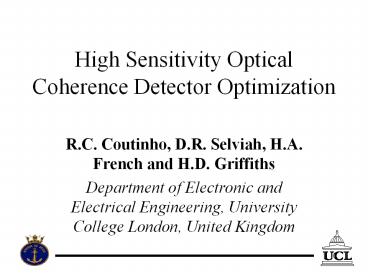High Sensitivity Optical Coherence Detector Optimization - PowerPoint PPT Presentation
1 / 12
Title:
High Sensitivity Optical Coherence Detector Optimization
Description:
Detector Reading (mV) The signal. Phase Step Detection Algorithm. Input ... Design of filter transmission curve is another degree of freedom to be exploited ... – PowerPoint PPT presentation
Number of Views:48
Avg rating:3.0/5.0
Title: High Sensitivity Optical Coherence Detector Optimization
1
High Sensitivity Optical Coherence Detector
Optimization
- R.C. Coutinho, D.R. Selviah, H.A. French and H.D.
Griffiths - Department of Electronic and Electrical
Engineering, University College London, United
Kingdom
2
Outline
- Technique Description
- Derivation of Theoretical Responsivity
- Description of the Experiment
- Theoretical Vs. Experimental Results
- Conclusion
3
Basics
- Technique combining optical and digital signal
processing to detect coherent or partially
coherent sources in an incoherent environment - Employs an optical narrowband filter to generate
a specific feature in the self coherence function
measured with an interferometer
- Unlike Fourier transform spectroscopy (FTS), the
path difference is scanned in a tiny region
surrounding the first minimum of the self
coherence function (interferogram), thus
achieving faster frame rates - The recorded interferogram is processed using a
computer algorithm to extract a phase step in the
fringe signal its position is used to declare
detection.
4
Theory
Detector Reading (mV)
F.T.
Path Difference (microns)
- If a spectrally narrow emission source enters the
field of view, the net degree of coherence of the
scene changes, shifting the position of the first
minimum in the self coherence function (see next
slide). This shift is measured and used for
detection - The approach senses the change in the spectrum
through measurements of the change in a region of
the interferogram, which makes it a lot faster
than other spectral approaches.
5
The signal
6
Phase Step Detection Algorithm
7
Derivation of Theoretical Responsivity
8
Experimental Arrangement
9
Target/Filter Combinations
10
Results - Responsivity
11
Results - Wavelength Offset
12
Conclusions
- Responsivity already high can be increased
twofold by careful choice of filter to target
optical bandwidth ratio - Design of filter transmission curve is another
degree of freedom to be exploited































